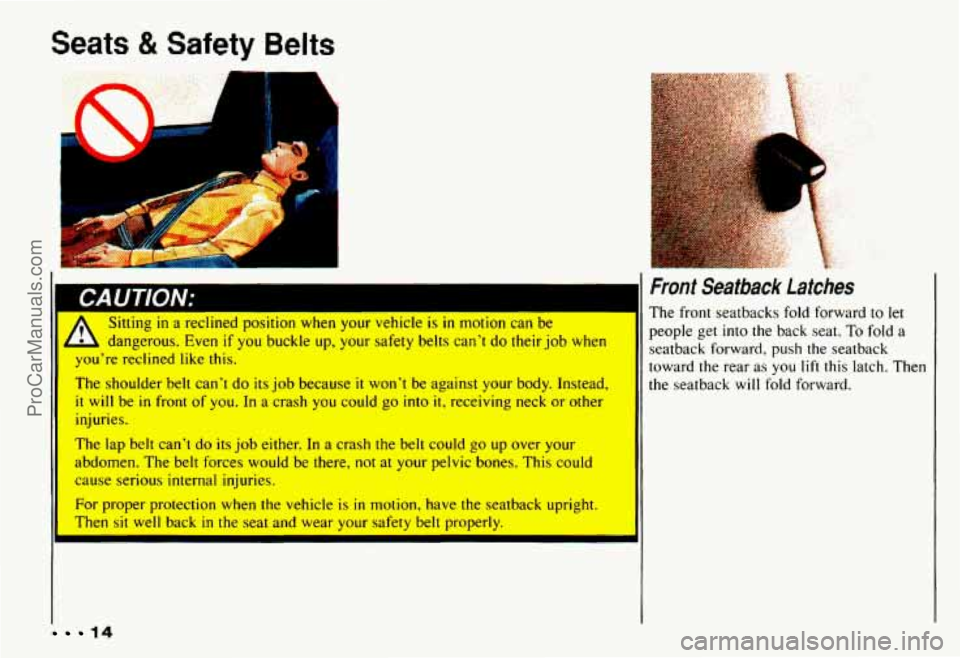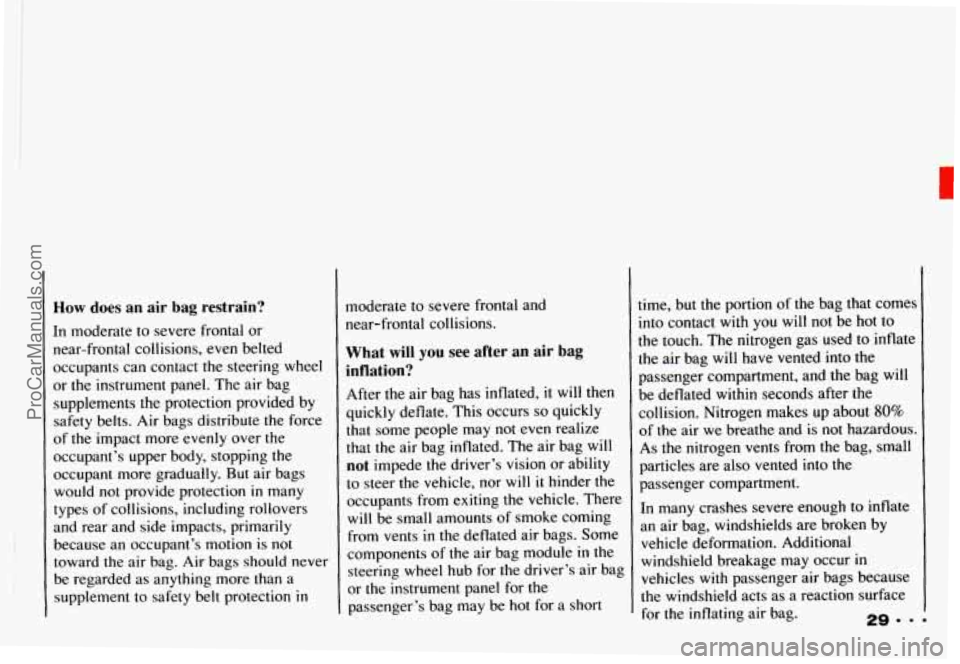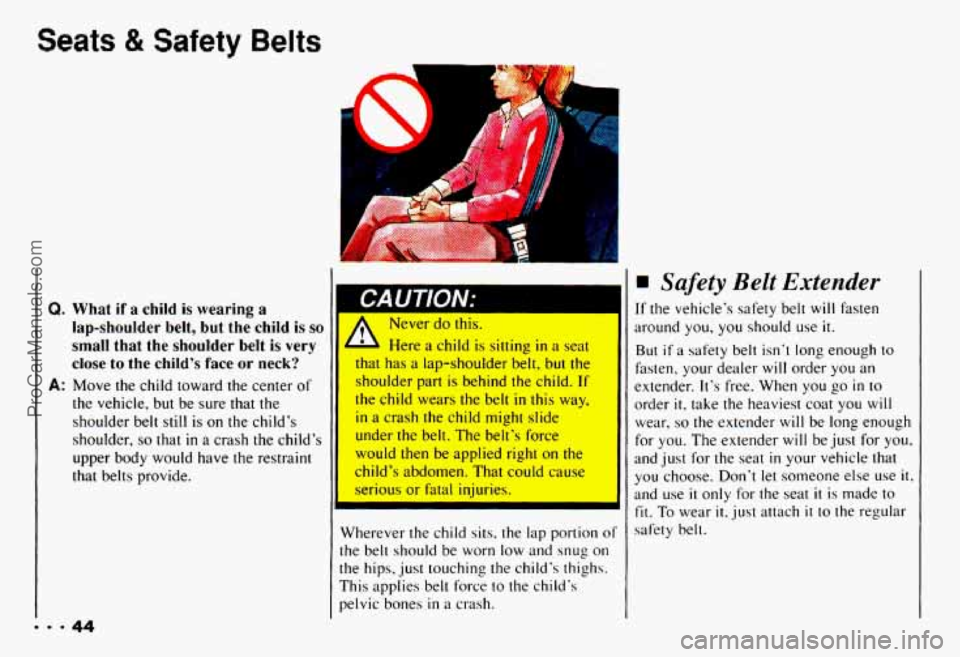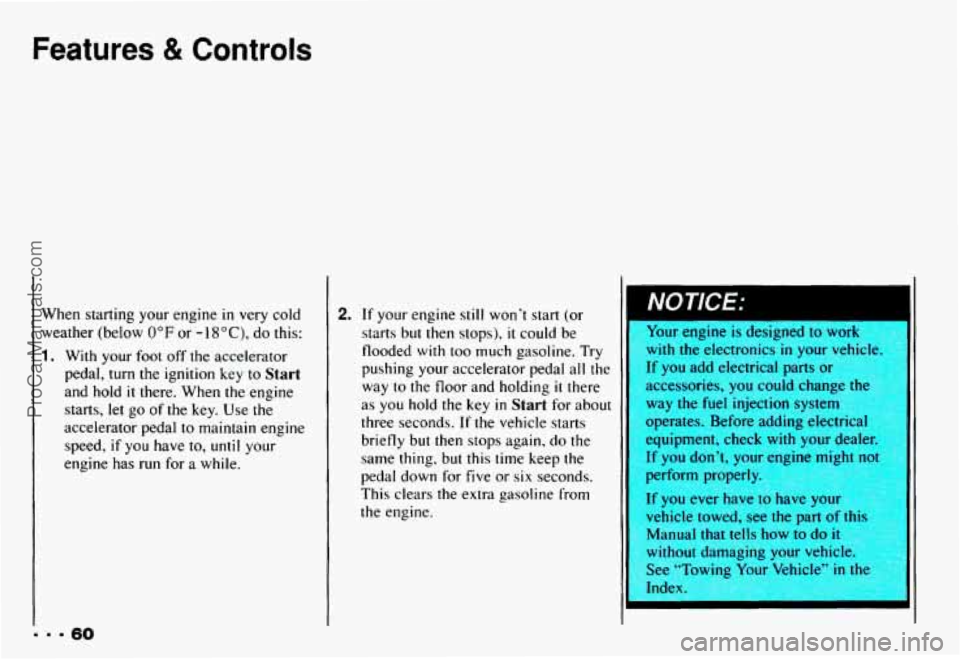1993 CHEVROLET CAMARO tow
[x] Cancel search: towPage 18 of 358

Seats 8t Safety Belts
II
A
Sitting in a reclined position when your vehicle is in motion can be
- dangerous. Even if you buckle up, your safety belts can’t do their job when
you’re reclined like this.
The shoulder belt can’t
do its job because it won’t be against your body. Instead,
it will be in front of you. In a crash you could go into it, receiving neck or other
injuries.
The lap belt can’t
do its job either. In a crash the belt could go up over your
abdomen. The belt forces would be there, not at your pelvic bones. This could
cause serious internal injuries.
For proper protection when the vehicle is
in motion, have the seatback upright.
Then sit
well back in the seat and wear your safety belt properly.
Front Seatback latches
The front seatbacks fold forward to let
people get into the back seat. To fold a
seatback forward, push
the seatback
toward the rear as
you lift this latch. Then
the seatback will fold forward.
14
ProCarManuals.com
Page 33 of 358

How does an air bag restrain?
[n moderate to severe frontal or
near-frontal collisions,
even belted
occupants can contact
the steering wheel
or the instrument panel. The air bag
supplements the protection provided by
safety belts. Air bags distribute the force
of the impact more evenly over the
occupant’s upper body, stopping the
occupant more gradually. But air bags
would not provide protection in many
types of collisions, including rollovers
and rear and side impacts, primarily
because an occupant’s motion
is not
toward
the air bag. Air bags should never
be regarded as anything more than a
supplement to safety belt protection
in
moderate to severe frontal and
near-frontal collisions.
What will you see after an air bag
inflation?
After the air bag has inflated, it will then
quickly deflate. This occurs
so quickly
that some people may not even realize
that the air bag inflated. The air bag will
not impede the driver’s vision or ability
to steer the vehicle, nor will
it hinder the
occupants from exiting the vehicle. There
will be small amounts of smoke coming
from vents
in the deflated air bags. Some
components of the air bag module
in the
steering wheel hub for the driver’s air bag
or the instrument panel for the
passenger’s bag may be hot for a short
t
1
t
t
I
1
4
1 1
r >
ime, but the portion of the bag that comes
nto contact with you will not be hot to
he touch. The nitrogen gas used to inflate _._ .~ ~
he air bag will have vented into the
Iassenger compartment, and the bag will
Je deflated within seconds after the
:ollision. Nitrogen makes
up about 80%
3f the air we breathe and is not hazardous.
As the nitrogen vents from the bag, small
particles are also vented into the
passenger compartment.
In many crashes severe enough to inflate
an air bag, windshields are broken by
vehicle deformation. Additional
windshield breakage may occur
in
vehicles with passenger air bags because
the windshield acts as a reaction surface
.~~ ~
for the inflating air bag. 29-9.
ProCarManuals.com
Page 48 of 358

Seats & Safety Belts
Q. What if a child is wearing a
lap-shoulder belt,
but the child is so
small that the shoulder belt is very
close
to the child's face or neck?
A: Move the child toward the center of
the vehicle, but be sure that the
shoulder belt still
is on the child's
shoulder,
so that in a crash the child's
upper body would have the restraint
that belts provide,
II
' Never do this.
- Here a child is sitting in a seat
that has a lap-shoulder belt, but the
shoulder part is behind the child. If
the child wears the belt in this way,
in a crash the child might slide
under the belt. The belt's force
would then be applied right on the
child's abdomen. That could cause
serious or
fatal injuries.
Wherever the child sits, the
lap portion 01
he belt should be worn low and snug on
he hips, just touching the child's thighs.
rhis applies belt force
to the child's
Jelvic bones
in a crash.
Safety Belt Extender
If the vehicle's safety belt will faten
around you, you should use
it.
But ifa safety belt isn't long enough to
fasten, your dealer will order you an
extender. It's free. When you
go in to
order
it, take the heaviest coat you will
wear, so the extender will be long enough
for you. The extender
will be -just for you,
and just for the seat
in your vehicle that
you choose. Don't let someone else use
it,
and use it only for the seat it is made to
fit. To wear it, just attach it to the regular
safety belt.
ProCarManuals.com
Page 59 of 358

Off (C): Unlocks the steering wheel,
ignition and automatic transmission, but
does not send electrical power to any
accessories. Use this position
if your
vehicle must be pushed or towed.
A
warning tone will sound if you open the
driver’s door when the ignition is
in Off
and the key is in the ignition.
Run (D): Position to which the switch
returns after you start your engine and
release the switch. The switch stays
in the
Run position when the engine is running.
But even when the engine is not running,
you can use
Run to operate your
electrical power accessories and to
display some instrument panel warning
and indicator lights.
ProCarManuals.com
Page 64 of 358

Features 8t Controls
When starting your engine in very cold
weather (below
0°F or - I SOC), do this:
1. With your foot off the accelerator
pedal,
turn the ignition key to Start
and hold it there. When the engine
starts, let go of the key. Use the
accelerator pedal to maintain engine
speed,
if you have to, until your
engine has run for
a while.
2. If your engine still won’t start (or
starts
but then stops), it could be
flooded
with too much gasoline. Try
pushing your accelerator pedal all the
way to the floor and holding
it there
as you hold the key in Start for about
three seconds.
If the vehicle starts
briefly but then stops again, do the
same thing, but this time keep the
pedal down for five or
six seconds.
This clears the extra gasoline from
the engine.
NOTICE:
1 Your engine is designed to work
with the electronics in your vehicle.
If you add electrical parts or
accessories, you could change
th
way the fuel injection system
operates. Before adding electrlcal
equipment, check with your dealer.
II
If you don’t, your engine might not
perform properly.
If you ever have
to have your
vehicle towed, see the part
of thi
Manual that tells how to do it
without damaging your vehicle.
See “Towing Your Vehicle’’
in th
Index
I I
ProCarManuals.com
Page 66 of 358

Features & Controls
I NOTICE:
I HTI~~ you-ve usea me DIOCK neater, I- sure to store the cord as it was
,-fore, to keep
it aw-f from movin
engine parts.
If you h’t ; $&add ,$a;!$$$,.
be damaged.
I
, . ,Q i ,,<.> . , t!!! h,~
I
How long should you keep the block
heater plugged in? The answer depends
on the weather, the kind of oil you have,
and some other things. Instead of trying to
list everything here, we ask
that you
contact
a Chevrolet dealer in the area
where you’ll be parking your vehicle. The
dealer can give
you the best advice for
that particular area,
... 62
Automatic
Transmission
There are several different positions for
your shift lever.
P (Park)
This locks your rear wheels. It’s the best
position to use when you start your
engine because your vehicle can’t move
easily.
It is dangerous to get out of
your vehicle
if rhe shift lever is
not fully in P (Park) with the
parking brake
firmly set. Your
vehicle can roll.
Don’t leave your vehicle when the
engine
is running unless you have
to. If you have left the engine
running, the vehicle can move
suddenly.
You or others could be
injured. To be sure your vehicle
won’t move, when you’re on fairly
level ground, always set your
parking brake and move the shift lever to
P (Park).
See “Shifting into
P (Park)” in the
Index.
If you are parking on a hill,
or if you’re pulling a trailer, also
see “Parking on Hills” or “Towing
a Trailer” in the Index.
ProCarManuals.com
Page 67 of 358

I
Ensure the shift lever is fully in P (Park)
range before starting the engine. Your
Chevrolet has a brake-transmission shift
interlock. You have
to fully apply your
regular brakes
before you can shift from
P (Park) when the ignition key is in the
0 R (Reverse)
Use this gear to back up.
11 NOTICE:
I Shifting to K (Reverse) while your
Run position. If you cannot shift out of vehicle is moving forward could
P (Park), ease pressure on the shift lever damage your transmission. Shift to
- push the shift lever all the way into R only after your vehicle is stopped.
P (Park) and also release the shift lever
button on floor shift console models as
you maintain brake application. Then
move the shift lever into the gear you
wish. (Press the shift lever button before
moving
the shift lever on tloor shift
console models.) See "Shifting out of
P (Park)" in this part.
To rock your vehicle back and forth to
damaging your transmission, see "Stuck:
In Sand, Mud, Ice or Snow, If You're"
in the Index.
L get out of snow, ice or sand without
N (Neutral)
In this position, your engine doesn't
connect
with the wheels. To restart when
you're already moving, use
N (Neutral)
only.
Also, use N when your vehicle is
being towed.
639 9
ProCarManuals.com
Page 68 of 358

Features & Controls
.
Shifting out of Y (Park) or
N (Neutral) while your engine
13 “racing” (running at high speed)
is dangerous. Unless your foot is
firmly on the brake pedal, your
vehicle could move very rapidly.
You could lose control and
hit
people or objects. Don’t shift out of
P (Park) or N (Neutral) while your
engine
is racing.
I I Damage to your transmission
caused by shifting out of P (Park) o
N (Neutral) with the engine racin;
isn’t covered by your warranty. ~ I
@ Automatic Overdrive
This position is for normal driving. If you
need more power for passing, md you’re:
- Going less than about 35 mph
(56 km/h), push your accelerator You’ll
shift down
to the next gear and
have more power.
D (Third Gear)
This is like @I , but you never go into
Overdrive.
Here are some times you might choose
D
instead of @ :
- When driving on hilly, winding roads
- When towing a trailer. so there is less
shifting between gears
pedal abou; halfway down.
I- When going down a steep hill
- Going about 35 mph (56 km/h) or
more, push the accelerator all the way
down.
ProCarManuals.com